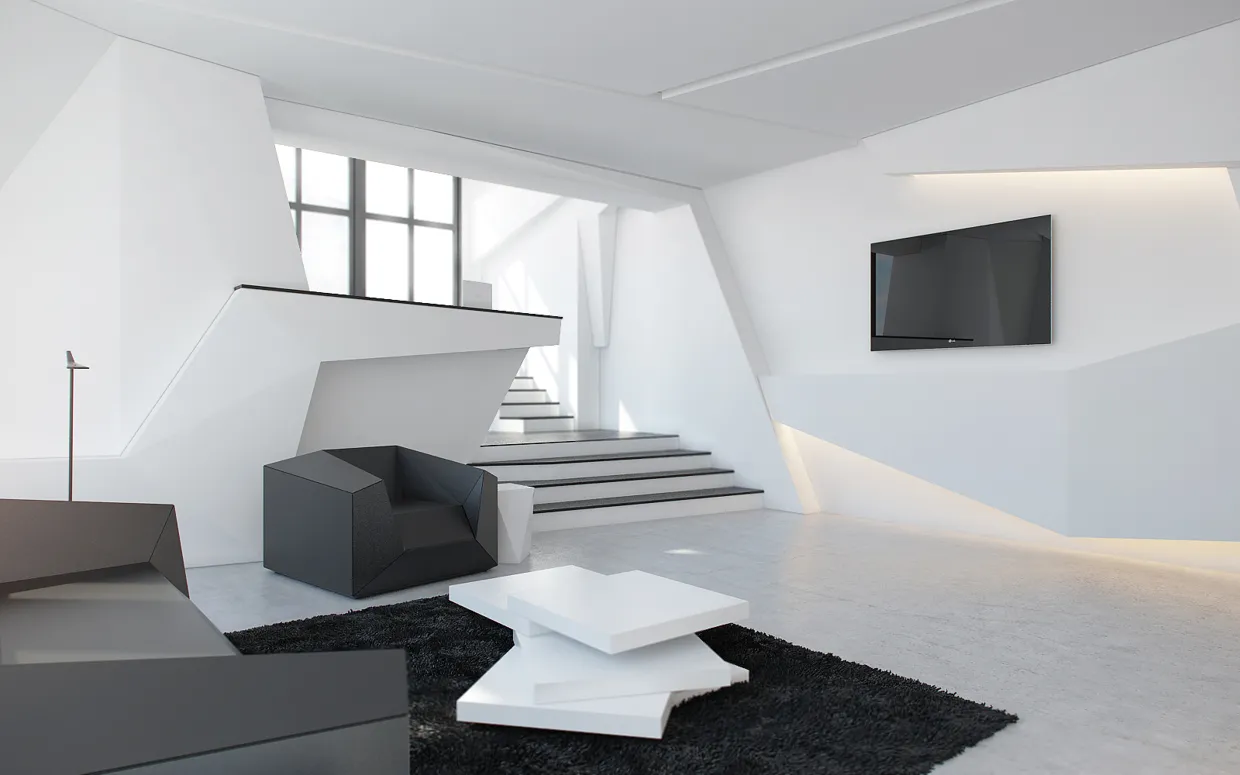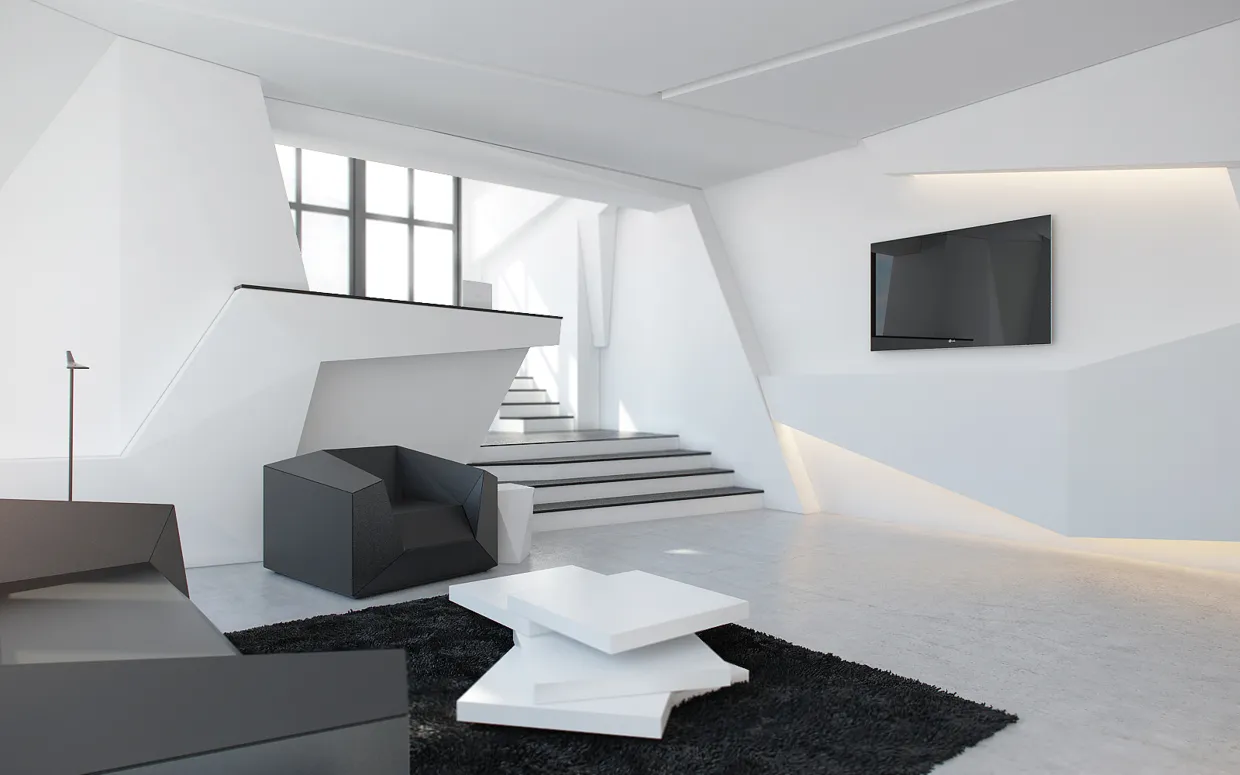
Introduction
The interior design has gone through evolution so many times, and it will continue to do the same in the future. The idea behind a futuristic design is to evoke images and boundaries of imagination of beautiful landscapes, which you may have seen mostly in sci-fi products. Besides being intriguing, these spaces also showcase cutting-edge technology and a fusion of artistry.
Futuristic Interior Design
As mentioned previously when we hear the term futuristic design, we relate it to sci-fi movies. Another advantage of having them in their arsenal is that it helps us glued to our seats. It is not only intimidating but also intriguing and futuristic. These feature monochromatic, metallic, and long dynamic lines. All of these things combine together to suggest urgency and motion. In today’s day and age, hi-tech and ultra-modern look has become famous. In the art genre, you can find architecture, painting, ceramics, sculpting, theatre, music, and interior design. You can also find wavy horizontal lines in the name of flooring. The dominant colors include black, white, and grey creating an illusion. Furthermore, glossy and shiny silver is also commonly used mystic blue, red, light green, yellow, and light green emphasizing the effect. Some of the materials used synonymously include glass, metal, leather, and plastic.
Futuristic Interior Design Elements
There are many elements and concepts related to futuristic design that shape the interior design of your home or office. Some of the illustrative examples and suggested strategies are given below.
Geometric Shapes and Futuristic Lines
The futuristic and sleek line is among the most popular appearance in today’s futuristic design. This appearance is archived by using elegant and simple furnishings. You can accomplish the appearance in many ways. On an overall basis, the effect is among modern and sophisticated. You can do this with sharp angles in the architecture of the home by using horizontal lines. You can also use curved lines to accomplish this appearance continuously. Furthermore, you can also use geometric shapes to achieve a futuristic design. You can do it by putting the walls of the room or home décor with geometric patterns.
Futuristic Furniture
While considering futuristic design, it cannot be accomplished without the inclusion of futuristic furniture. It is characterized due to its innovative materials and its avant-garde designs. These include both the function and the form included within futuristic furniture. The definition of such furniture may be considered incomplete without praising its unconventional, sleek, and minimalistic style. These often incorporate materials like plastics, metal, leather, and glass. Even though comfort and ergonomics are integral, they are also cutting-edge.
Today as a part of futuristic design, smart furniture is gaining momentum and integrated with technologies. These include shape-shifting designs, built-in speakers, and charging ports. These elements feature a bold chromatic palette to contribute to the practicality and futuristic allure of the interiors.
Hidden Storage and Concealed Spaces
For committing to a minimalist futuristic design, the unnecessary items need to be kept away. This is how you can improve your space by creating a futuristic appearance. Use doors or false walls for creating hide-off or secret storage. Choose the furniture in which you have to install hidden compartments. These hidden storages give the architecture of your home with futuristic design.
Transparent and Reflective Materials
Within the domain of futuristic design, you can also find transparent and reflective materials. Transparent and reflective materials define futuristic design as an interior design element. This imparts a sense of innovation and spaciousness. Reflective surfaces include polished metallic finishes, mirrored walls, or glossy acrylics. These amplify the play of light or create an illusion of expanded space within the futuristic design. These impart a sense of sophistication, modernity, and futurism to the space. Transparent materials include see-through partitions, glass walls, or acrylic furnishings. Materials like these connect with interior spaces while part of the external environment, encouraging penetration of natural light.
Smart Home Technology
In the age of digital media, one of the futuristic design trends is to use smart home technology. There are many multi-functional home appliances and modern gadgets that serve the purpose. These include touch-controlled controls and automated lighting.
The key to futuristic design lies in automation, and thus every appliance will have a central system, through which you can control them. From curtains to air-conditioning and smart lighting, door locks, window blinds, and sound systems. These appliances will automatically perform specific actions or turn off or on. For instance, when the room is dark, the lights will turn on automatically, depending on the situation. Today, you can use these systems through voice-activated assistants, phones, or smart systems. Voice-activated assistants include Google Home or Amazon Alexa.
Sci-fi influences and cues
Science fiction films are considered ideal inspirations for several interior designs. Utopian visions, spaceships, and sleek technology visions actually act as muse. These incorporate materials such as LED lighting, metallic surfaces, and holographic displays. When incorporated, these mimic interstellar landscapes. To evoke extra-terrestrial worlds, it features unconventional shapes and bold color palettes. The design result seamlessly combines functionality with fantasy, interacting with the future and inviting occupants to explore.
Futuristic Lightings – Neon or LED lights
Futuristic lighting featuring Neon or LED is also among the important aspects of creating futuristic design within interior spaces. A futuristic interior features modern and clean lights. This means one needs to avoid fixtures of traditional lights such as table lamps or chandeliers. But it is better to choose neon or LED instead. These stylish and sleek lights provide any space with a futuristic design. Beginning from the top, these lights can feature alongside the ceiling’s sleek lines. These lights may feature on the edges of the room and wall fixtures.
Concealed and Camouflaged Storage Spaces
If you are looking for a minimalistic futuristic design for your interiors, then integrate innovative storage solutions. These include concealed and camouflaged storage spaces, serving the purpose and fostering the environment. This helps achieve streamlined aesthetics and futuristic interiors within every inch. Walls may hide pull-out shelving or cabinets while storage units get double for staircasses. To further maximize the utility, make use of innovative mechanisms. These include retractable seating and pop-up countertops to boost utility to the maximum.
Retro-Futuristic Design
One of the unique and fascinating designs is retro-futuristic design. In recent years, it has gained significant popularity. It is linked with futuristic touches and blending elements, thus resulting in a forward-thinking look and nostalgic appeal. As compared to other styles and designs, these are not focused on a particular era but connect futuristic touches with the past. Hence, they take inspiration from several periods and a combination of each of them gives them an appealing outlook. But the retro-futuristic design is something to consider as a one-of-a-kind appearance. Hence, you can get both a modern and nostalgic appearance sandwiched in one.
Origins of Retro-Futurism
Retro-futuristic design roots date back to the mid-20th Century. At that period, people were intrigued about how it would look in the future. Classical movies such as Blade Runner and Metropolis are considered prime examples that feature futuristic worlds combining Art Deco design and science fiction. The “Atomic Age” style is among the iconic examples of futuristic interior design. Thus, things like these tempted the designers to create clothing, furniture, and interiors. While focusing on past elements, it also included a futuristic feel.
It was during the 60s and 50s that retro-futuristic design became popular. It featured geometric shapes, futuristic motifs, organic forms, and bold colors. It was inspired by the Atomic Age and Space Race and it reflected excitement and optimism of the time.
Key Elements of Retro-Futuristic Design
There are many elements involved in retro-futuristic design. These are as follows:
Geometric Shapes and Patterns:
In a retro-futuristic design, you can find several geometric patterns and shapes. These include squares, triangles, and circles. You can create a futuristic feel while combining them with past-related elements.
Bold Colors
A retro-futuristic design also includes bold colors e.g. bright yellow and orange. The design includes vibrant and bold colors that remind people of the era of the 50s and 60s. Such colors create excitement and a sense of energy.
Metallic and Shiny Finishes:
The retro-futuristic design includes often metallic and shiny finishes. These include stainless steel and chrome that incorporate past elements. Metallic and shiny finishes create a feel that looks futuristic while still part of the past events.
Streamlined Furniture:
The style of design often incorporates streamlined and sleek furniture. These are aesthetically pleasing and functional.
Futuristic Touches
The last in the list of retro-futuristic designs is adding futuristic touches. These may include holographic accents and LED lighting. Hence, you can include progress and innovation with these touches.
Conclusion
The futuristic design is featured in several modern apartments today. Here you can find creative furniture pieces and a remote or a touch panel. The decor on the other hand is reduced and replaced by bright accents, abstract paintings, or original photos. Skilled professional interior designers can use unique futurism styles and minimalist designs for offices and apartments and focus on functionality maintenance.
Also Read
Remodel Your Home With The Latest Interior Design Trends In 2024
